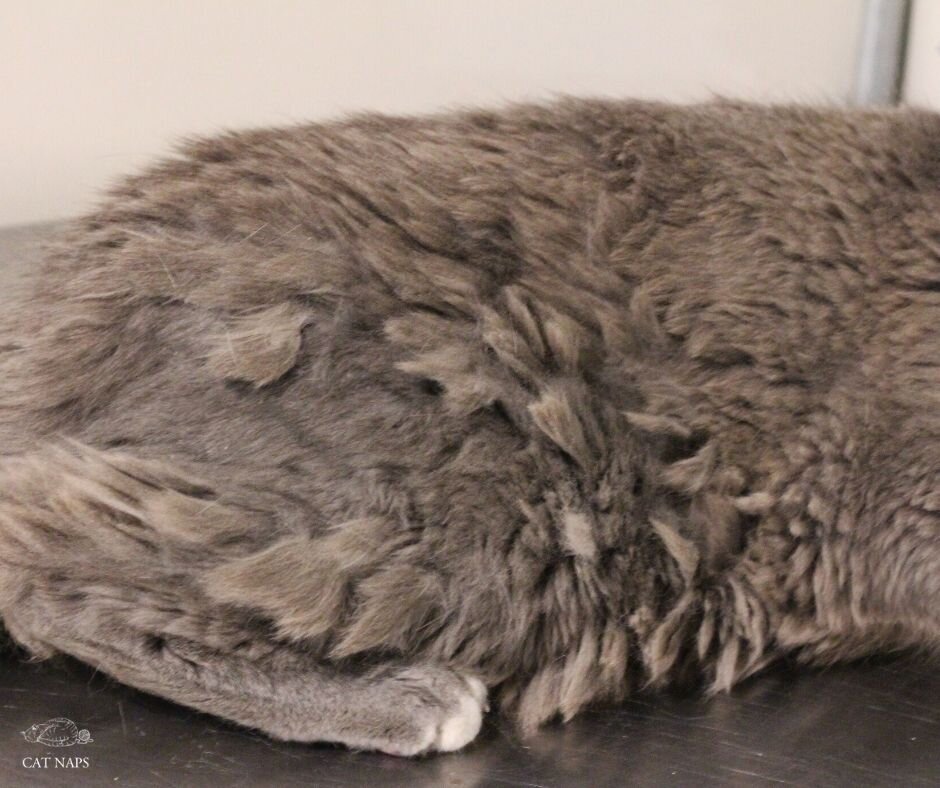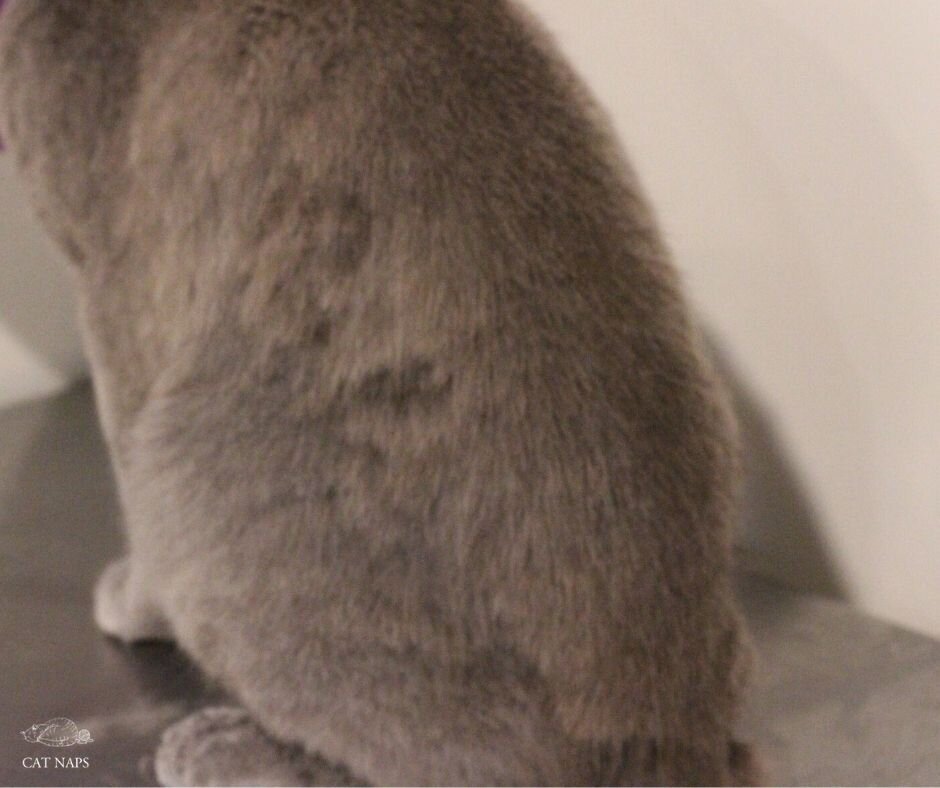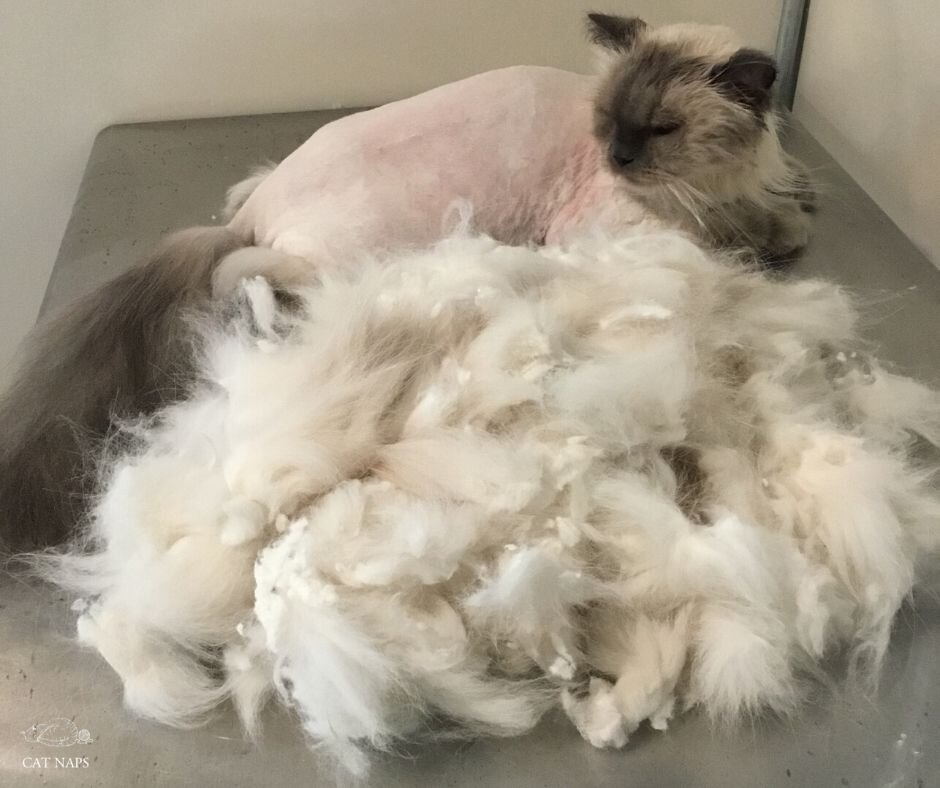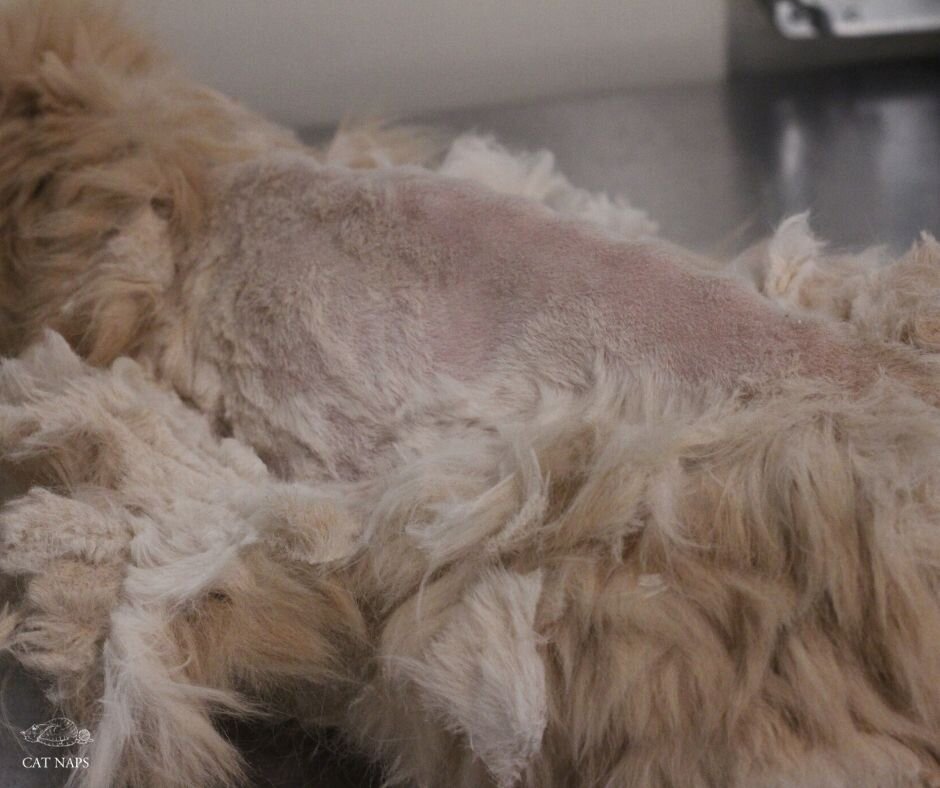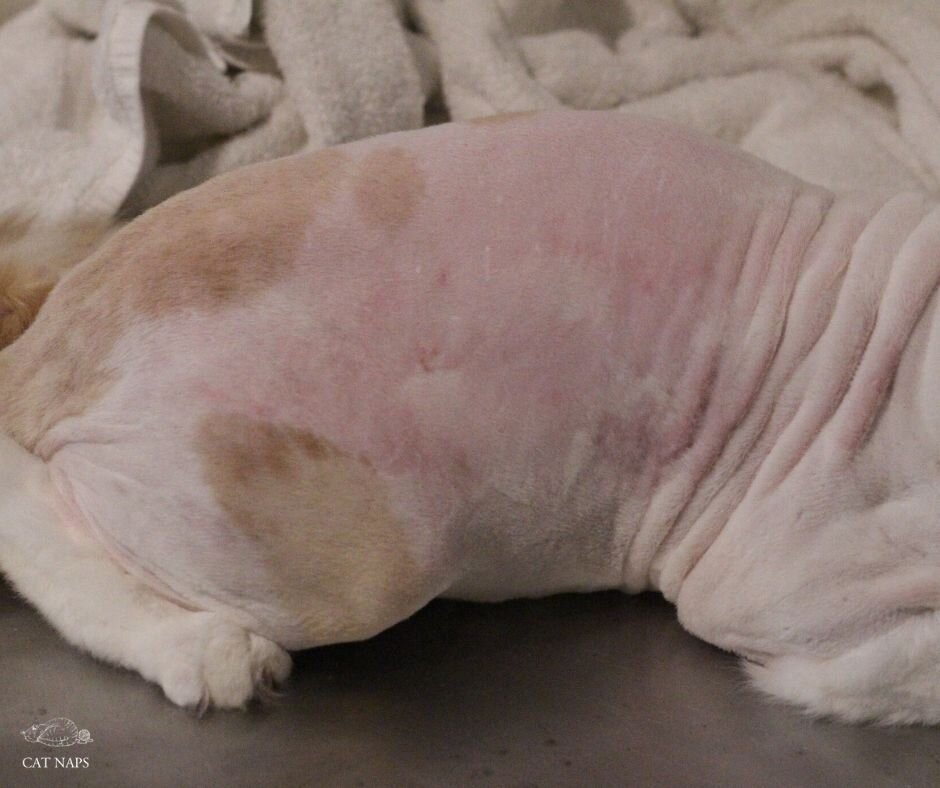How to Remove Cat Matting
When a cat develops matting, there are only a few options as to how they can be removed: either they are shaved out completely or they are combed out. Cat mats are made up of clumps of dead hair, oily skin cells, and any goodies the cat has rubbed against on the floor, under the bed or furniture, or even from outside. Because it is primarily a mass of dead hair, it can’t be brushed out. It would be similar to trying to brush out a Brillo Pad. They also can’t be broken apart or cut through with scissors because it won’t make the mat removal process any easier. Skin can also be caught up inside the mat, which can be cut if using scissors on the mats.
Do NOT use scissors, seam rippers, dematting rakes or other sharp tools as they can severely cut and damage your cat’s skin.
DeMatting Sprays or Conditioners for Cat Matting
Since cat mats aren’t tangles, they won’t benefit from brushing or using any sprays or “de-matting” products. These products are designed to make the hair slippery or smooth so that the hairs can be brushed out without causing further damage, but since dead hair is already broken and damaged the sprays, creams or conditioners won’t make it easier to remove.
Adding in these types of products can actually do more harm than good on your cat’s hair. Dematting sprays can stay in the coat, which then can be licked when the cat begins self-grooming later. These sprays often include fragrances, silicones and other ingredients that are not designed to be ingested by cats. Heavy conditioners can weigh down the cat’s coat making it gummy and hard to comb through, even after rinsing it out. And if you’ve ever tried to comb through a gunky coat, you’ll know that cats hate it!
Does My Cat Need to Be Shaved?
These smaller mats on a short-haired cat (yes, even short-haired cats can get matted!) have the potential to be combed out instead of requiring shaving. However, this will depend on the cat’s reaction to any combing.
Now that we’ve established cat matting can’t be brushed out, sprayed out or washed out, what options are available? The two ways of safely removing mats are either combing them out fully or shaving them out with professional pet clippers. To determine which way will be safer and less stressful on your cat, your groomer will consider the following factors:
Size of each mat
Location and size of each matted area
Cat’s age, skin condition and behaviors
Not every cat will be a willing participant of mat removal, especially if the mats are large, tight and causing discomfort. But, cat matting will not go away on its own. It will need to be removed before it can cause further pain and damage to the skin. If you are uncomfortable with either of the techniques below, then the best thing would be to reach out to a professional cat groomer near you for the best options for your cat.
This is the same cat pictured above, after a gentle mat removal by Certified Feline Master Groomer Lynn at Cat Naps Cattery. This was done during a bath, blow dry and comb out. There are still some bald spots (shown by the discoloration in the coat), but overall no shaving needed.
Combing Out (Small) Cat Mats
If the matting is small, approximately the size of a nickel or smaller, then there is a good chance they can be combed out without needing clippers. A sturdy metal comb that is at least 6-8” in size will be the best tool for this job. Very small combs or flea combs have teeth that are too close together to get the matting out without pulling too much hair at the same time.
When you have the cat sitting in a comfortable position, locate the mat and gently move the hair around it away so you can focus just on the mat itself. Typically, these small mats will only be attached to the cat’s skin with a handful of hairs underneath the mat. Slip your comb completely underneath the mat, without getting any of the hairs around it into the comb. Then use your non-comb hand to hold the skin above the mat firmly. You don’t want to pull the comb and have the skin move too as you won’t get the mat out. If you have done both of these things, you should be able to give one swift tug towards you to get the mat out. It won’t hurt the cat as long as you are holding the skin away from you and you only have the hairs immediately beneath the mat in the comb. Most cats will become agitated when you try to “pick” a mat apart, or if you aren’t holding the skin firmly. Think of removing a bandaid. If you are trying to slowly pick it off bit by bit it can often be much more painful than a quick removal with the right technique.
Certain areas of the cat’s body may make it more challenging to remove small mats by combing. They may have to be shaved out even though they fit the size recommendations. These areas can include behind the ears, the sanitary area and around the genitals, armpits and any other sensitive areas for your cat.
Remove Cat Matting with a Clipper
This sweet kitty needed a full Lion Cut to remove all the matting. This should only be attempted by a professional cat groomer or at a veterinary clinic.
When matting is too large, too tight or in too sensitive an area, shaving may be the better option compared to combing them out. Combing can pull and rip the cat’s coat, which is certainly very uncomfortable for their skin. A professional pet clipper with a #10 blade can often remove the mats more quickly and without any additional tugging of the skin.
There are techniques that need to be used to do this safely however. Clippers can also do damage to delicate cat skin if not used appropriately, and sometimes it may even be unavoidable no matted how experienced the person clipping is. Clipper blades are sharp and are designed to cut. If the cat’s skin wrinkles or gets caught up inside the teeth of the clipper blade, the skin can get nicked and even bleed. Because cat’s skin moves when they walk and stretch, even small cuts can rip and expand into larger wounds. Any skin injury should be seen or discussed with your veterinarian for appropriate treatment.
Even though there are risks with shaving, some mats can only be removed this way. The clipper must sit flat on the cat’s skin and the cat must be prevented from moving or wiggling (without causing them additional stress). Only small areas should be worked on at a time, and only areas that you can fully see should be clipped. Cat matting can pull bits of skin up into the mat, hiding it from view and making it very easy to cut.
When Should I Take My Matted Cat to the Groomer
In many cases, matting should only be removed by a professional cat groomer. They are trained in how to reduce stress during handling, grooming and mat removal. If you are uncomfortable using the above techniques, aren’t sure where to start, or if your cat is responding negatively when you touch or try to comb out the mats, then calling a pro will be your next step.
These mats are being removed during a professional cat grooming appointment. The cat is elderly with thin, delicate skin and had matting all over. This level of severe matting removal should only be removed by a professional groomer or a veterinarian.
Your groomer will evaluate your cat when you go to drop off, so they can assess the condition of the matting, your cat’s skin and body condition, how they react to being handled, etc. They’ll use all of this information to determine the best course of action to safely remove the matting, what your groom will include and how much it will cost. Large and severe mat removal can get expensive (even into the hundreds of dollars depending on your area and the type of groomer you visit), so it is best to schedule an appointment as soon as you notice any issues in your cat’s coat.
In some cases, the groomer may determine that the safest option for your cat will be to see your veterinarian for a groom under anesthesia. This comes with its own set of risks and costs, but for some cats it may be the only option if the cat becomes too stressed during a normal grooming appointment, the mats are very severe or the cat becomes aggressive during handling or grooming. Each groomer has a different approach to cat grooming, so it can be beneficial to seek more than one opinion. However, make sure to be up front with the groomer about your cat’s condition and previous behaviors when making any appointment so you won’t be surprised or disappointed if the options or pricing is different the day of the appointment.
What Happens After My Cat’s Mats Are Removed?
Whether combing or shaving, many mats will leave a bald spot behind once removed. This is caused by the matted hair pulling at and damaging the skin. There can even be areas of redness, irritation and even bruising uncovered during the mat removal. This is all normal and should heal on its own without additional treatment. In rare cases of severe matting, there can be open wounds, fleas or other parasites, lesions or other skin issues underneath the matting that are only revealed after it is clipped off. Any of these should be checked by a veterinarian for treatment.
In some cases of mat removal, a hot spot can develop a few days later. This is caused by the cat licking itself over and over again in the same spot. Cats do this because the matting is pulling tightly on the skin and once the mats are removed, the skin is more sensitive, sore or itchy. If a cat begins licking an area obsessively, it can turn into a hotspot from self-mutilation.
Areas of redness caused by tight matting is revealed after shaving.
What is a Hot Spot? Sometimes referred to as clipper burn, this is an area of irritation that develops a few days after mat or excess coat removal. When the pet licks itself over and over in one area, the skin becomes red, wet and even a bit weepy. Clipper burn is not an actual burn caused by heat, but irritation of the skin similar to razor burn from shaving. Sometimes it is caused by a short blade or one that needs sharpening, but in most cases of mat removal it is caused by licking or scratching by the pet after the appointment.
Here are some tips for preventing a hotspot or area of clipper burn from developing:
Put a cone or e-collar on the cat temporarily to prevent them from licking or scratching. Your cat should return to normal behaviors within a few days and shouldn’t need the cone after that.
Have the cat wear a tee-shirt or onesie to cover the sensitive areas that are most prone to irritation. Once the hair begins to grow back 1-3 weeks later, then a shirt is no longer necessary.
Prevent matting with regular grooming services. The best way to eliminate the risk of irritation is to help your cat maintain a clean, mat-free coat.
Do NOT use any sprays, ointments or medications unless directed by your vet.
Removing matting on a cat can be very challenging, but in many cases your local professional cat groomer can offer assistance. Certain cat breeds, colors and coat types can be more prone to matting, but every cat can be susceptible to mats (yes, even short-haired cats!). Check out our article How Do Cats Get Matted? for more information and view our grooming articles for how to prevent your cat from developing mats by getting on an appropriate grooming schedule.
If you are looking for a professional cat groomer, we recommend Certified Feline Master Groomers (CFMGs) with the National Cat Groomers Institute. They have a map of both members and CFMGs available by clicking this link.


